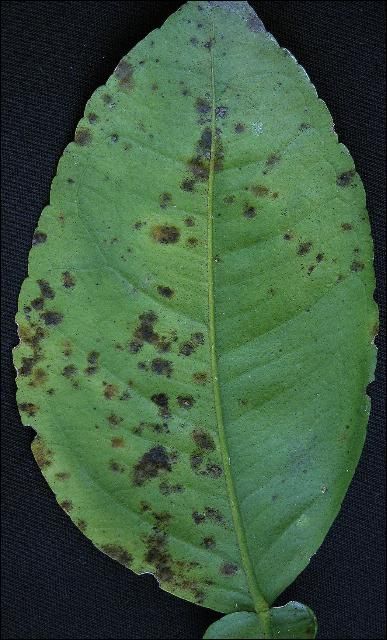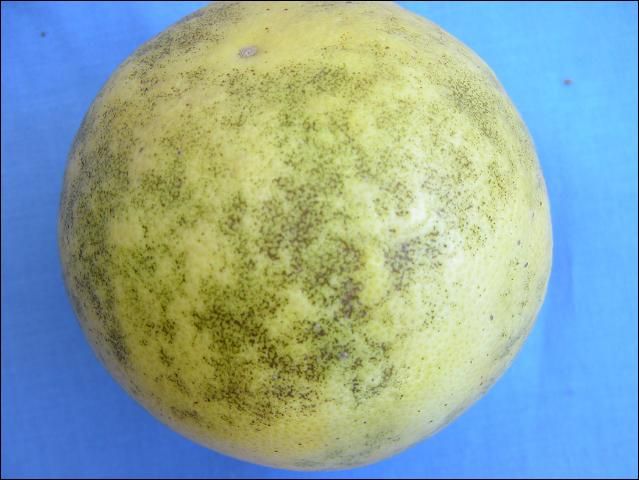Greasy spot is a disease that's frequently found in tropical and semitropical regions where citrus cultivars are grown. The disease is caused by Mycosphaerella citri. Symptoms appear as yellow to dark brown to black lesions occurring first on the underside of mature citrus leaves (Fig. 1). As the lesions develop on the underside of the leaves, they become darker and a corresponding chlorotic spot will appear on the upper leaf surface. These yellow (chlorotic) spots occur when infected cells fail to develop chlorophyll. Lesions are more yellowish and diffuse on lemons and grapefruit and more raised and darker on tangerines. Affected leaves fall prematurely from the tree during the fall and winter resulting in reduced tree vigor and yield. Greasy spot also infects the fruit of grapefruit trees producing rind blotch.

Credit: UF/IFAS CREC
The fungus that causes the disease reproduces by spores on infected and decaying leaves which are on the soil surface. The spores (ascospores) are ejected or released into the wind in response to leaf wetting from rain, irrigation, or heavy dew. Major spore release occurs from April through July. Spores are released into the wind and dispersed within the grove or to nearby groves. Once the spores germinate on the undersurface of the leaf, they grow and penetrate the leaf stomata which are natural openings in the leaf surface which regulate gas exchange between the air and the leaf. After penetration, the fungus grows slowly for several months causing cellular swelling. The swollen tissue starts to collapse and turn brown and eventually black. Several months will pass between infection and the first appearance of visual symptoms in the fall of the year (November - January). Infected leaves usually fall from the tree in late winter (January) to early spring (February) making this time period optimum for surveying groves to determine disease pressure and to develop control programs for the next season.
High humidity, above 90%, or high moisture favors spore germination and germ tube growth into the leaf. Infection is enhanced with long periods of leaf wetting or high temperatures which frequently occur on most nights from June to early October. Little infection will occur during the winter (December - February) due to cool temperatures and lower humidity and to low spore numbers. Leaves are susceptible to infection throughout their life when environmental conditions are favorable for disease development.
Fruit
When fruit is infected, small, necrotic (dead tissue), black spots are produced on the fruit surface with the surrounding area retaining a green color longer which is called greasy spot rind blotch (Fig. 2). The rind blotch is a significant problem on grapefruit that is being produced for the fresh market.

Credit: UF/IFAS CREC
Leaves
Leaves of grapefruit, tangelos, and lemons are the most severely affected varieties but all commercial varieties are affected to some extent. Within the orange varieties, early and mid varieties (Hamlin and Pineapple) are more susceptible than late oranges (Valencia).
Historically, affected leaves were normally cultivated into the soil in normal weed control practices thereby reducing inoculum. With the switch to chemical weed control, leaves remain on the soil surface longer allowing for greater production of inoculum. Additionally, as groves were converted to low volume irrigation from overhead irrigation, the frequency of leaf litter wetting has increased allowing for a more rapid release of spores that subsequently infect citrus leaves. Prior to the implementation of low volume irrigation, the major infection period was in June or July. With the more rapid release of spores and earlier decomposition of leaf litter, the infection period had been moved forward into May when environmental conditions are less favorable. As the leaves decay, the production of spores is reduced.
Management
Greasy spot should be controlled regardless of the intended market for the fruit. The best time to assess disease severity is to observe canopy density and premature leaf drop during February and prior to the emergence of the spring flush. The previous grove history and variety will also affect severity.
In Florida, greasy spot is usually controlled with a single application of oil or oil and copper in mid-May to June or two spray applications which are timed to be applied in mid-May to June with the second application in late July. On more susceptible varieties, like grapefruit or tangelos, copper is usually required to be incorporated into the spray to achieve successful control. Petroleum oil reduces the penetration of the spores into the leaf, but does not reduce spore germination. Thus the main action of oil is to reduce greasy spot by preventing or delaying the development of symptoms, even when the pathogen is already established deeply in the leaf.
For information on recommended chemical control products, please refer to Florida Citrus Production Guide: Greasy Spot — https://edis.ifas.ufl.edu/cg018.